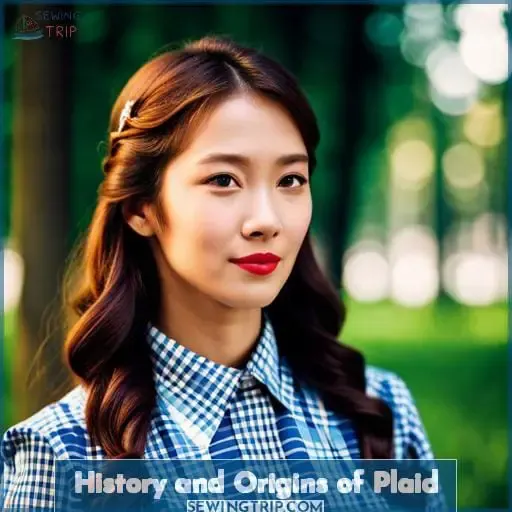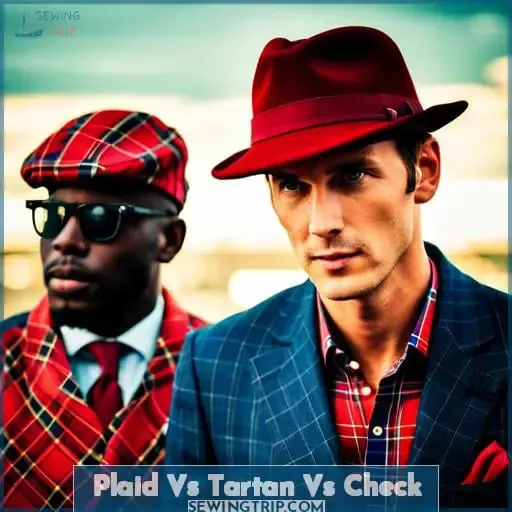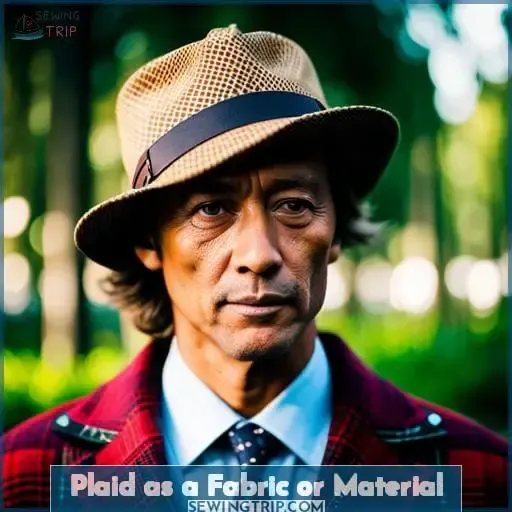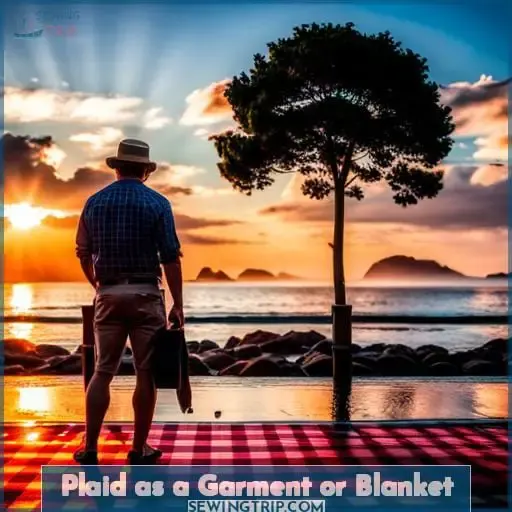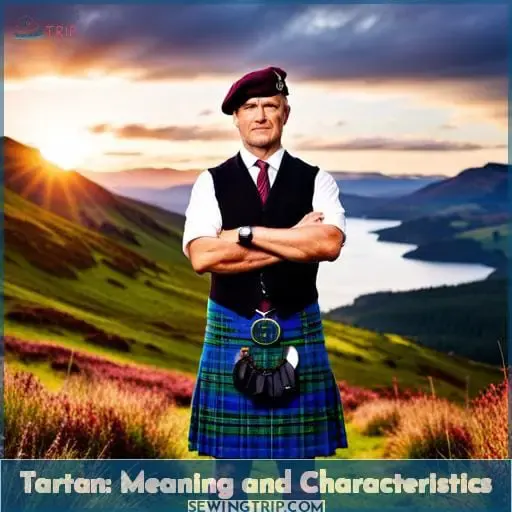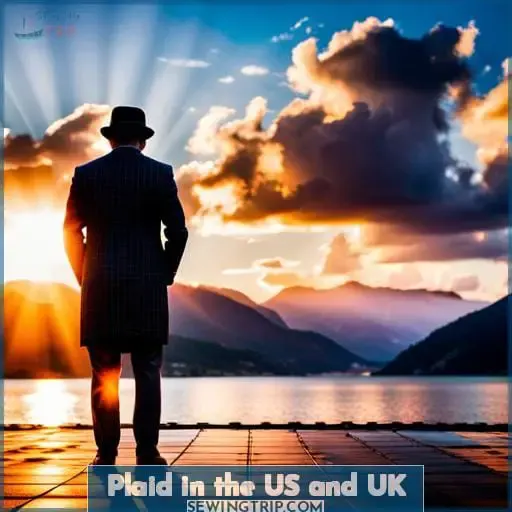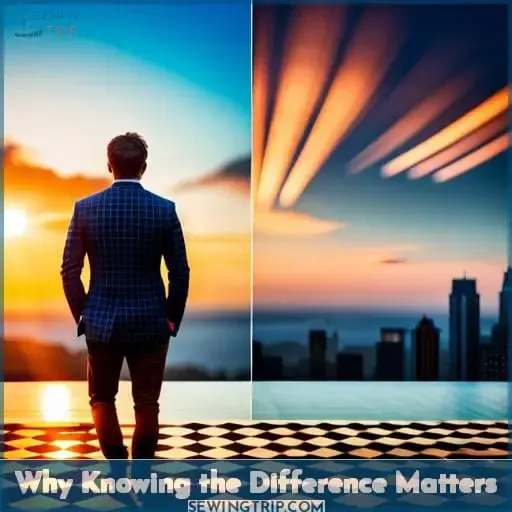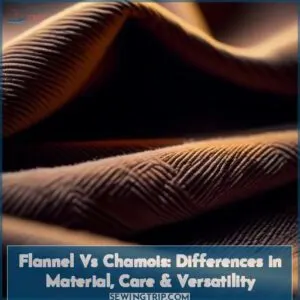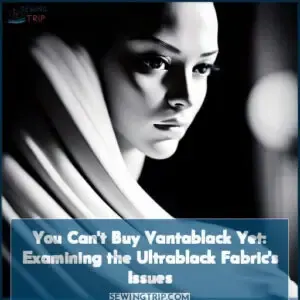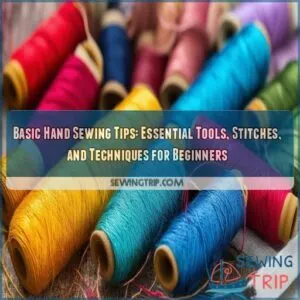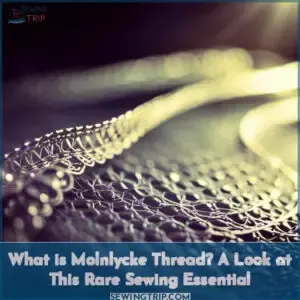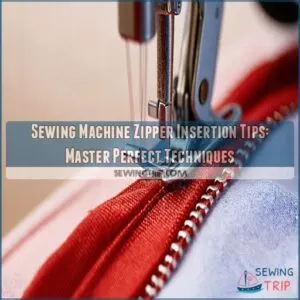This site is supported by our readers. We may earn a commission, at no cost to you, if you purchase through links.
Picture a roaring fire in the fireplace, a steaming mug of mulled cider, and you cocooned in a cozy plaid blanket. An image of warmth, comfort, and style – that’s what ‘plaid’ evokes! But did you know there are various types of plaids? Plaid vs tartan is one such comparison often made by people when they talk about fabric patterns.
Tartans have been around for centuries as part of Scottish culture, while modern-day checkered prints fall under the category called ‘plaid’.
In this article, we will explore why understanding the distinction between plaid vs tartan matters so much – right down to their definitions, characteristics, differentiations between countries, etc.
Table Of Contents
Key Takeaways
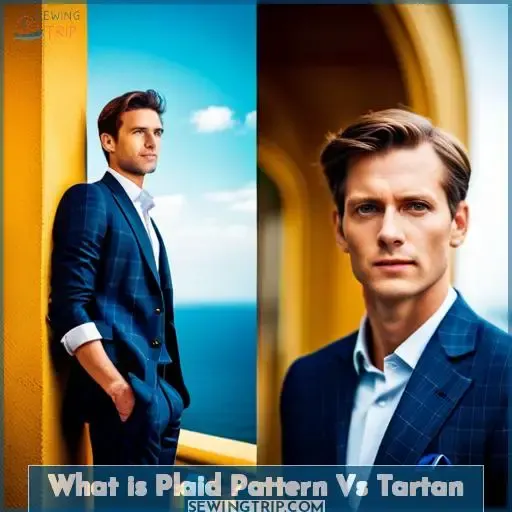
- Plaid and tartan are fabric patterns, with tartans being a part of Scottish culture for centuries and plaid being a more modern version of the crisscross pattern.
- Tartans have specific names and are associated with clans, while plaids can be any crisscross pattern of two or more colors.
- Tartans must always have a recognized name or history behind them and must be registered with the Scottish Tartan Authority for authenticity when purchasing.
- Tartans have a repetitive nature that makes them easily recognizable, while plaids often feature repetition in some sections but not necessarily across the whole length.
History and Origins of Plaid
You may have heard of the iconic Scottish plaid, but did you know its history dates back to ancient times and has been used to tell apart friends from foes in battle? Plaid is an old Scottish word for a blanket or wrap that describes a crisscross pattern of tartans or similar.
The fabric woven in these patterns was traditionally made from wool or a wool/linen mix.
Each locality had its own designs incorporating local plant-life for dyes, which became known as tartan. It wasn’t until the 19th century that this cloth was formally associated with clans. Kilts and other Highland Dress outfits are commonly accessorized with plaid worn over the shoulder – called the fly.
American usage sees plaid as any checked cloth, while they use ‘tartan’ when referring to one associated with a clan identification.
An important distinction between Plaids versus Tartans lies within their repetitive lines: whilst both contain horizontal and vertical stripes intersecting at 90-degree angles, only Tartans maintain such form uninterrupted across the fabric length!
Plaid Vs Tartan Vs Check
You may be wondering what the difference is between plaid, tartan, and check patterns. Plaids are any crisscross pattern of two or more colors. Tartans have a name to identify a community. Checks usually have a regular pattern with only two colors. Each fabric has its own distinct characteristics that make it unique.
Tartans should always have an identifiable name, appear irregularly throughout, and can be designed online, while check fabrics tend to feature regularly repeating stripes. Plaid, on the other hand, often features repetition in some sections but not necessarily across the whole length.
Different Criss-cross Patterns
Beyond the iconic Scottish blanket, criss-cross patterns come in many different varieties. From traditional tartan fabrics to checked cloths of two or more colors, plaid patterns have been used for centuries as a way to identify clans and kilt outfits.
Local plant life is often used to create dye for these colorful pieces, like the fly plaid draped over shoulders, arisaid plaide worn by women, and shepherd’s or drummer’s plaid popularized by pipers.
Plaids are versatile; they can be simple checks with regular patterning but also incorporate clan identifiers into intricate designs that never lose their unique charm across generations.
Definition and Characteristics
Discovering the definition and characteristics of criss-cross patterns can be a delightful journey, from traditional motifs to dye techniques. Fabric types range from simple checks to intricate designs with pattern recognition tied to specific clans.
Kilt styles like the belted plaid and piper’s plaid incorporate these patterns in unique ways, while tartan fabrics have their own distinct ‘sett’ pattern. The word ‘plaid’ refers to both the cloth itself and an accessory worn over Highland dress outfits, while tartans are associated with specific clans and registered with authorities for design protection.
Plaid as a Fabric or Material
Feel the warmth and comfort of traditional Scottish fabrics, like wool or a wool/linen mix woven with crisscross patterns of two or more colors. Plaid is an old Scottish word for a blanket or wrap with three overlapping but distinct meanings.
It describes the pattern, fabric in those tartan-style patterns, and types of garments. Tartans should always have an identifiable name associated with a clan and appear irregularly throughout, while check fabrics usually feature regularly repeating stripes.
Plaids differ from tartans in that their sett pattern is not necessarily present across its whole length. They can be used as both a garment accessory and cloth material using dyes from local plant-life to create unique colors.
Plaid has been incorporated into Highland dress since the 16th century when it helped differentiate friends from foes in battle due to its association with clans.
Plaid as a Garment or Blanket
You’ll be wrapped in warmth and comfort with a traditional garment, like the belted plaid or fly plaid, that will leave you feeling as cozy as can be! Plaids are not only used for cloth materials but also for garments like blankets.
The Scottish plaid has been worn since the 16th century and comes in various styles such as arisaid, shepherd’s, or piper’s plaids. These garments were originally used to differentiate friends from foes during battles due to their clan associations.
Woven fibers of wool or wool/linen mix give these plaids durability, while local plant dyes create unique colors, making each garment one-of-a-kind.
Whether it’s draped over your shoulder at a Highland Games event or snuggled up on your couch at home, a traditional tartan blanket is perfect for any occasion!
| Garment Style | Description |
|---|---|
| Belted Plaid | A long piece of fabric fastened around the waist with excess material thrown over one shoulder |
| Fly Plaid | A smaller section of fabric pinned onto jacket lapel with excess material draped across back |
| Arisad Plaid | Traditional women’s dress style made by wrapping an open-ended rectangular length around upper body leaving arms free |
Table: Different Styles Of Scottish Garments.
Tartan: Meaning and Characteristics
Experience the unique characteristics of tartan, a fabric woven with patterns of colored check boxes and intersecting lines associated with a clan. Tartans have their roots in Scotland’s Gaelic language, where plaid originally meant ‘blanket’.
The traditional weave is made from 100% pure worsted wool, which is dyed using natural plant-life for color.
Each local area had its own favorite designs to differentiate friends and foes in battle, becoming known as tartan. Clan Scotweb even has an online design service so you can create your own! Check patterns are another form of plaids that usually consist of two colors instead but still feature crossed horizontal and vertical lines forming squares throughout the cloth.
While all tartans are technically plaids, not all plaids can be called a true tartan – only those registered by Scottish Tartan Authority qualify! Plaid remains an accessory to Highland Dress outfits; draped over one shoulder or snuggled up on your couch at home, it’ll keep you warm no matter what occasion!
Plaid in the US and UK
You may be familiar with the terms plaid and tartan but unsure of how they differ. In the US, plaid refers to any checked cloth of two or more colors, while in the UK, it generally means a long rectangular-shaped piece worn over one shoulder.
Tartans are distinguishable by their patterns, which can include stripes forming squares throughout. These should always have a recognized name or history behind them and must be registered with the Scottish Tartan Authority for authenticity when purchasing! It’s important to understand that all tartans are technically plaids, though not all plaids can qualify as true tartans.
Understanding the Differences
Understand the difference between a tartan and a plaid – the former is registered by the Scottish Tartan Authority with unique, historically inspired patterns, while the latter is characterized by two-color check designs that are sure to keep you cozy in modern times.
Traditional tartans were woven from wool or wool/linen mix using natural plant-life for dyes, while plaids of any crisscross pattern can be found in many forms today.
Tartans have repetitive lines throughout that don’t change. Plaids differ as their sett pattern isn’t always present.
Kilts feature an over shoulder ‘plaid’ made from pure worsted wool. US citizens use ‘tartan’ for clan-associated plaid designs.
Checks feature regular patterns usually of two colors, but unlike true tartans, they cannot provide clan associations or traditional history.
Purchasing and Ordering
When it comes to shopping for plaid and tartan fabrics, you have many options. In the UK, shops like MacGregor and MacDuff offer a range of traditional plaids for purchase. In the US, look for tartans associated with specific clans or opt for generic plaid designs.
Many online retailers allow customization of tartan patterns using services like Scottish Tartan Design Service. Remember that true tartans are woven from wool while plaids can be any crisscross pattern in various forms today.
| Cloth Types | Pattern Names | Ordering Options |
|---|---|---|
| Wool Tartan 100% Pure Worsted Wool Kilt Fabric | Black Watch Clan Tartan | Purchase a Plaid from Shops Like MacGregor & MacDuff (UK) |
| Poly-Viscose Adult Kilts – Modern Hybrid Blend | Heritage of Scotland Tartan | Some Plaid Can Be Ordered Online (US) |
| Muted Colors & Traditional Patterns | Royal Stewart Red | Customize Your Own Designs Using Scottish Tartan Design Services. |
Why Knowing the Difference Matters
It’s important to know the difference between plaid and tartan for a variety of reasons.
Plaids, which are any crisscross patterns of two or more colors, can be used to show clan identity or simply for fabric choice when styling an outfit.
Tartans have a specific set pattern that must always be present and should also have a recognized name with history behind it. They need to be registered with the Scottish Tartan Authority before purchase if you wish them to retain authenticity.
The repetitive nature of these designs in tartans makes them easily recognizable – something that cannot necessarily occur with regular plaids due to their lack of sett patterning throughout the cloth length.
So understanding this distinction is key not only when selecting your fabrics but also in recognizing various clans’ traditional patterns at events like Highland Gatherings!
Being knowledgeable on this subject allows us all access into Scotland’s rich cultural heritage, making sure we appreciate both the importance behind each design as well as its aesthetic appeal too!
Frequently Asked Questions (FAQs)
What is the difference between plaid and tartan?
Plaid and tartan are both crisscross patterns of two or more colors, but the key difference is that tartans have a recognized name or history. Tartans should always be woven from wool, with each locality having its own favorite designs.
Plaid garments for kilts and other Highland dress date back to the 16th century in Scotland. In the US, tartan refers to plaid associated with a clan, while plaid means any checked cloth of two or more colors.
What colors are traditionally used in tartan fabrics?
Tartan fabrics traditionally use earthy and muted colors, such as browns, greens, blues, and reds. There are also brighter colored tartans in more modern designs. Tartan was historically woven using dyes derived from local plant life to create unique patterns for clans to recognize each other on the battlefield.
Is it possible to design a custom tartan?
Yes, it is possible to design a custom tartan. Using the Scottish Tartan Authority’s tartan design service, you can create unique and vibrant designs that express your personal style while still embracing traditional patterns.
How long has the plaid garment been a part of Highland Dress?
Plaid as a garment has been a part of Highland Dress since the 16th century. Worn over the shoulder, its tartan design allowed clans to distinguish friends from foes in battle.
Does tartan have any specific meaning or symbolism associated with it?
Yes, tartan has specific meaning and symbolism associated with it. Historically, tartans were woven from local plant life to create unique dyes for the cloth. Tartan was also used to help differentiate friends from foes in battle. Today, tartans are registered with the Scottish Tartan Authority and can have a variety of symbolic meanings depending on their clan or pattern origin.
Conclusion
To wrap up, the difference between plaid and tartan is fundamental. Both feature crisscross patterns formed by intersecting horizontal and vertical lines. However, tartan is always regular and contains a recognizable pattern with a history associated with a clan.
Plaid fabrics, on the other hand, may be irregular or regular, but are not associated with a clan.
Plaid is used to create garments and blankets, while tartans are used to make kilts and highland wear. Knowing the difference between the two is essential, especially if you’re in the US or UK where there are differentiations between the two.
Plaid can be a great way to add texture and color to any outfit, and with the right knowledge, you can add that extra touch of style – like a cherry on top of a cake.

